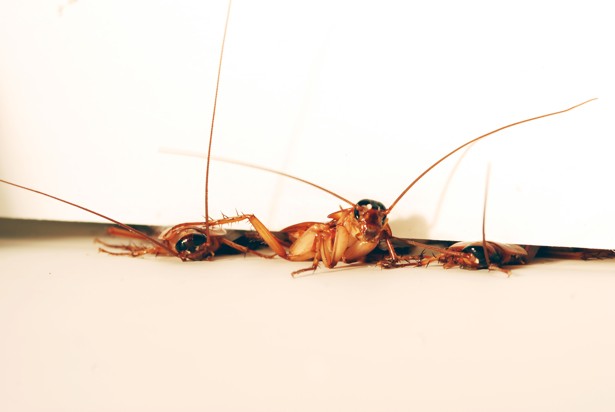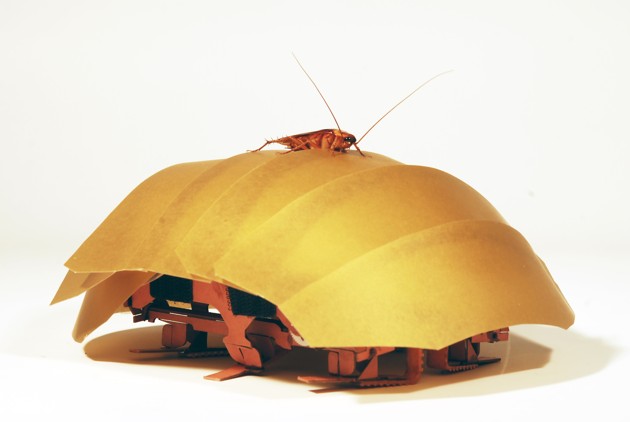
Cockroaches get everywhere. There they are, somehow, against all odds, in that room that looked to be totally sealed from the outside world, in that cupboard you swore was tightly shut. Now, Kaushik Jayaram and Robert Full from the University of California, Berkeley have discovered the secret behind their feats of infiltration.
By confronting American cockroaches with an ever-narrower series of crevices, the duo found that although this insect typically stands 12 millimeters tall, it can squeeze through gaps of 3 millimeters—the height of two stacked U.S. pennies. It does this by squatting down and then compressing its body by half. It is the world’s worst Transformer: instantly changing shape from a cockroach into a much flatter cockroach. Delightful.
Even worse, the compressed cockroaches are still disarmingly fast. Even though their legs are splayed and their bodies are squished, they can still scuttle at 60 centimeters per second. “Scale that up to human size, and it’s like 70 miles per hour,” says Full. “They can run at high speed inside your walls and ceilings.” Hallelujah.
This ability seems doubly extraordinary because cockroaches, like all insects, have rigid exoskeletons. Soft-bodied animals like worms or octopuses can intuitively squeeze through tight spaces—just watch this octopus go—but it’s less obvious how a roach does it. “It’s not just crunchy, rigid parts,” explains Full. The exoskeleton consists of hard plates connected by soft, flexible membranes that act as hinges. Even the solid parts are variable, with some sections being 10 times less stiff than others. The result is a creature that can change shape without sacrificing its infamous indestructibility. Joy untold.
To test just how compressible the exoskeleton is, Jayaram and Full “performed a series of dynamic compressive cycle tests on living animals.” In other words, they squished roaches beneath a metal piston. They found that when the insects squeeze through the tiniest of crevices, they experience compressive forces around 300 times their own body weight. They can actually withstand 900 times without suffering any damage whatsoever, or even slowing down. Good job, evolution; now, go home.
“It’s a nice lesson in humility,” says Daniel Goldman from the Georgia Institute of Technology. “These animals are not simple in any way, shape, or form—and especially not in their shape or form.”
Full specializes in the physics of animal movements. He discovered how geckos stick to walls and steer while falling, and how octopuses walk on their tentacles to mimic coconuts. And he has been investigating cockroaches for over 14 years, looking at how they run, fly, and climb. He has shown that they can swing under ledges like a pendulum to instantly disappear from sight, run upside-down on a branch, flip themselves up with their wings if they land on their backs, run having lost four of their legs, and climb having lost their feet. Full has even stuck tiny jetpacks onto them to see how they cope with being blasted to the side while climbing—very well, it seems.
Full’s team then takes what they learn from real animals, and builds robots that have the same skills. For example, Jayaram has now constructed a compressible cockroach bot, which looks like a yellow woodlouse, and folds in much the same way as its living counterpart. It stands 75 millimeters tall, and can be squashed to just 35 millimeters.

These bioinspired bots are physical models that allow the researchers to check that they’ve understood the animals they’re studying. “We can try a bunch of different legs and bodies and say: What does it tell us about the animal? Are we missing anything?” says Full.
But the robots also have practical uses. Picture RoboRoach scuttling through the rubble of a collapsed building to track down survivors, squeezing through cracks without taking damage or losing speed. Jayaram is now working on making RoboRoach smaller and autonomous, and Full has been talking to first-responders at disaster sites to see what their needs are. “Imagine having a swarm of these and throwing them out to get information as fast as possible,” he says.
The study helps to rethink locomotion in robots, says Cecilia Laschi from the Biorobotics Institute in Italy. She and others have been building soft robots, inspired by flexible animals like octopuses and jellyfish. Eschewing hard shells and skeletons, these machines use floppy and stretchy materials instead.
But these creations often sacrifice speed and strength in the service of pliability. Cockroaches don’t. “People are modeling slugs and worms for soft robotics, but we think these cockroaches are the way to go,” says Full. “They have appendages like ours, and muscles that can generate a lot of force.”
Jayaram and Full “are serving as biology translators, who can give us roboticists ideas on how to really build systems with some of biology’s features,” says Howie Choset from the Georgia Institute of Technology. “When I was done reading their paper, I wanted to build a robot with these capabilities for search and rescue!”